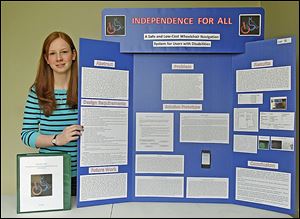
Ida teen wins engineering honors
International competition in Phoenix is next
3/25/2013
Kathryn Hite’s project — ‘Independence for All: A Safe and Low-Coast Wheelchair Navigation System for Users with Disabilities’ — took top honors at the Southeast Michigan Science Fair.
IDA, Mich. — Kathryn Hite is attracting attention for her engineering prowess.
The 17-year-old took the first-place grand award this month in the Southeast Michigan Science Fair at Washtenaw Community College with a project she calls “Independence for All: A Safe and Low-Cost Wheelchair Navigation System for Users with Disabilities.”
Her project also was the first-place winner in the computer science and mathematics category, and took the University of Michigan’s Women in Science and Engineering Award.
Kathryn’s wins qualify her to compete with her project in the Intel International Science and Engineering Fair in Phoenix in May. Her expenses will be paid, and she’ll compete against more than 1,600 students from around the world during the week-long event.
“I’m looking forward to it,” she said.
The student has an earnest purpose in mind as she tweaks her project for the Phoenix competition. Her goal is to develop an affordable retrofit for powered wheelchairs that would enable users with cognitive and physical disabilities to travel a pre-mapped route. The project is only in the virtual stage right now: it exists in her computer, but hasn’t been tried on a real wheelchair.
She system she wants to develop would use relatively inexpensive, off-the-shelf components.
“The idea is to make it cheap. The cost could be kept under $700, not counting the wheelchair,” she explained. “It uses Microsoft Kinect to map the environment and for obstacle avoidance. The actual route is stored on an onboard computer. It stores what the Kinect sees.”
One shortcoming she readily acknowledges is that the system would work only indoors. That’s because the Kinect “is messed up by sun; it can’t take in images when the sun is glaring at it.”
Microsoft Kinect, for the uninitiated, is a motion sensing device used with the Xbox 360 video game console and Windows PCs. Users can interact with a video game using gestures instead of a game controller.
On a standard powered wheelchair with a joystick control, Kathryn said, her system would take over the joystick commands. The next phase of her project is to develop a working prototype. That won’t start until after the Phoenix competition.
Kathryn lives with her parents, Angela and Bill Hite, sister Kelsey, 14, and brother Cooper, 10. She is home-schooled by her mother, with the exception of the calculus class she takes at Ida High School, where she’s a junior, and plans to study computer science in college.
She has an internship with the artificial intelligence research lab at the University of Michigan, and is on the FIRST Robotics team at Monroe County Community College, where she is team president as well as a programmer, operator, and builder of the competitive robots.
She also is principal flute for the Toledo Symphony Youth Orchestra’s Symphonic orchestra, captain of the Ida High School Quiz Bowl team, and a volunteer at the Monroe County Intermediate School District Educational Center.
“We’ve always encouraged our kids to have passions,” her mother said. “We’re just excited that she’s found this [wheelchair project] and is pursuing it.”